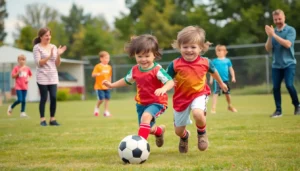Table of Contents
ToggleAs the sun blazes and school lets out, it’s time for kids to trade in their textbooks for sports gear. Summer sports not only keep them active but also unleash their inner champions. Whether they’re diving into the pool or scoring goals on the soccer field, these activities are a fantastic way for kids to stay fit while having a blast.
Overview of Summer Sports for Kids
Summer sports for kids provide fun ways to stay active during the warm months. Swimming stands out as a favorite, engaging children in a refreshing activity that also boosts cardiovascular fitness. Soccer serves as another popular option, encouraging teamwork and enhancing coordination among young players.
Tennis offers a great alternative, requiring agility and hand-eye coordination. This sport allows kids to develop skills while enjoying friendly competition. Basketball captures attention through its fast-paced nature, promoting fitness and social interaction within teams.
Track and field events impress with their range of activities, from sprints to long jumps. Such events allow children to explore various physical challenges while fostering a spirit of achievement. Outdoor adventure sports like kayaking encourage kids to connect with nature, enhancing their love for the outdoors.
Martial arts play an essential role in summer sports, teaching discipline and self-defense techniques. Programs often blend physical training with mental focus, resulting in well-rounded development for children. Softball captures interest as a classic team sport, promoting cooperation and strategic thinking in players.
Families should consider local community programs and sports camps to help children find enjoyable activities. Engaging in summer sports opens opportunities for lifelong friendships and improved health. Each sport offers unique benefits, making it easy for kids to discover what they love.
Benefits of Summer Sports
Summer sports provide numerous advantages for kids, enhancing both their physical and social development.
Physical Health
Engaging in summer sports significantly boosts children’s physical health. Activities like swimming promote cardiovascular fitness, which supports a strong heart and lungs. Soccer, requiring running and quick movements, improves overall endurance and coordination. Tennis emphasizes agility, helping kids develop speed and quick reflexes. Basketball’s demands for jumping and sprinting increase muscle strength while improving flexibility. Participating in various sports reduces the risk of obesity, as it encourages regular exercise during the summer months. Children develop a healthier lifestyle and learn the importance of staying active early on. Overall, summer sports present multiple pathways for kids to achieve optimal physical health.
Social Skills
Summer sports play a vital role in developing children’s social skills. Team activities, such as soccer and basketball, foster collaboration and communication among players. Kids learn to share success and handle defeat gracefully, which builds emotional resilience. Friendships often form through shared experiences during sports practices and games. Moreover, participating in sports camps creates a sense of community and belonging. Children also develop essential leadership skills by taking on various team roles. These interactions contribute to improved self-esteem as kids navigate social dynamics in a fun environment. In summary, summer sports provide valuable opportunities for children to cultivate social skills that last a lifetime.
Popular Summer Sports for Kids
Engaging in summer sports provides children with excellent opportunities to stay active, learn teamwork, and develop various physical skills. The following sports are particularly popular among kids.
Soccer
Soccer stands out as one of the most beloved summer sports. This game enhances teamwork as players work together to score goals. It promotes cardiovascular fitness, agility, and coordination through its fast-paced nature. Kids develop essential skills like communication while participating in games and practices. Opportunities abound in local leagues and camps, ensuring that most children can join in the fun. Friendly competition encourages kids to improve and strive for their personal best, making soccer an excellent choice for summer activity.
Swimming
Swimming ranks as a top favorite among children during summer months. This activity provides full-body workouts, improving cardiovascular health and muscle tone. Kids enjoy individual and group swimming sessions, often in community pools or summer camps. Safety awareness becomes a crucial part of the experience, teaching children essential water skills. Swimming also serves as a refreshing way to cool off on hot days while, at the same time, enhancing endurance and flexibility through various strokes. Lifelong enjoyment of swimming can develop, making it a valuable skill.
Baseball
Baseball offers a classic summer sport, with a rich tradition that captivates players of all ages. This sport focuses on skills like hand-eye coordination, batting, and fielding. Kids learn sportsmanship through teamwork and strategy during games. Local leagues provide opportunities for children to participate at various competitive levels. Additionally, baseball enhances physical fitness through running, throwing, and hitting activities. Coaches often emphasize the importance of practice, fostering discipline and patience in young athletes.
Tennis
Tennis appeals to many kids seeking a fun, engaging outdoor activity. Playing this sport promotes agility, speed, and coordination through quick movements and strategic plays. Individual and partner games allow children to develop both competitive and social skills. Finding local tennis clubs or camps enables kids to learn and improve their game. Moreover, tennis instills a sense of achievement as players progress in their skills, making it a rewarding sport to pursue throughout the summer.
Tips for Encouraging Participation
Encouraging kids to engage in summer sports involves a few strategic approaches. Parents and guardians can play a crucial role in this process.
Finding the Right Sport
Exploring various sports helps children discover their interests. Assessing their preferences, whether they favor team or individual activities, can unveil what excites them most. Soccer might appeal to some for its fast pace, while others may prefer the tranquility of swimming. Parents should also consider the child’s physical abilities and past experiences. Providing options allows for informed choices that cater to their strengths. Local community centers often offer introductory classes, making it easier for kids to sample different sports before committing.
Creating a Positive Environment
Fostering encouragement boosts kids’ willingness to participate in sports. Celebrating small achievements, such as mastering a new skill, enhances confidence and motivation. Parents can create a supportive atmosphere by attending events and showing interest in their children’s activities. Emphasizing fun over competition nurtures a love for the sport, reducing pressure. Additionally, forming connections with other families involved in the same sport promotes a sense of belonging. Structured practices and playdates with friends can solidify friendships and enhance the overall experience, contributing to lasting engagement in summer sports.
Safety Considerations
Engaging in summer sports requires careful attention to safety. Parents should ensure kids wear proper gear that fits well and complies with safety standards. This includes helmets for biking, knee pads for skateboarding, and appropriate footwear for soccer.
Hydration plays a crucial role in keeping children safe. Encourage kids to drink water before, during, and after activities, especially in hot weather. Limiting outdoor sports during peak sun hours can also prevent heat-related illnesses.
Supervision is essential when children participate in water sports. Lifeguards or responsible adults should always oversee swimming activities, especially in open water settings. Teaching children about water safety boosts their ability to react to emergencies.
In addition, encouraging proper warm-up and cool-down routines helps prevent injuries. Stretching and gradual physical activity prepare muscles for the effort required. Likewise, cooling down allows the body to recover.
Communicating about sports rules can minimize risks. Clear discussions about fair play reinforce safety and sportsmanship. Educating children on the importance of reporting injuries, no matter how minor, promotes awareness and quick action.
While enjoying summer sports, keeping these safety considerations in mind supports fun and reduces potential hazards. Prioritizing safety ensures healthy experiences for children in their chosen activities.
Engaging in summer sports offers kids a wealth of benefits that extend beyond physical fitness. These activities foster social connections and build essential life skills. By encouraging participation in sports like swimming, soccer, and tennis, families can help children discover their passions while promoting a healthy lifestyle.
With the right support and guidance, kids can thrive in a positive environment that values fun and teamwork. Prioritizing safety and proper preparation ensures that summer sports remain enjoyable and rewarding. Ultimately, the memories and friendships formed during these activities can last a lifetime, making summer sports an invaluable part of childhood development.






